Analysis of Net Primary Productivity of Retired Farmlands in the Grain-for-Green Project in China from 2011 to 2020
Abstract
1. Introduction
2. Materials and Methods
2.1. Identification of Retired Farmlands from GFGP
2.2. NPP Estimation for the Retired Farmlands
2.3. Analysis of Spatial and Temporal Variation in NPP
2.4. Analysis of Driving Forces for NPP Variation
3. Results
3.1. Spatial Distribution Patterns of Retired Farmlands
3.2. Spatial and Temporal Variation in NPP on Retired Farmlands
3.3. Factors Affecting NPP
4. Discussion
4.1. Retired Farmlands
4.2. NPP of Retired Farmlands
4.3. Factors for NPP Variation
4.4. Limitations and Uncertainties
5. Conclusions
Supplementary Materials
Author Contributions
Funding
Data Availability Statement
Acknowledgments
Conflicts of Interest
References
- IUCN. The Bonn Challenge 2020. Available online: https://www.bonnchallenge.org/ (accessed on 7 November 2022).
- Hendricks, N.P.; Er, E. Changes in cropland area in the United States and the role of CRP. Food Policy 2018, 75, 15–23. [Google Scholar] [CrossRef]
- Deng, L.; Liu, G.; Shangguan, Z. Land-use conversion and changing soil carbon stocks in China’s ‘Grain-for-Green’ Program: A synthesis. Glob. Chang. Biol. 2014, 20, 3544–3556. [Google Scholar] [CrossRef] [PubMed]
- Johnson, J.; Reicosky, D.; Allmaras, R.; Sauer, T.; Venterea, R.; Dell, C. Greenhouse gas contributions and mitigation potential of agriculture in the central USA. Soil Tillage Res. 2005, 83, 73–94. [Google Scholar] [CrossRef]
- Molly, H. Planting carbon storage. Nat. Clim. Chang. 2018, 8, 556–558. [Google Scholar] [CrossRef]
- Yang, Y.H.; Shi, Y.; Sun, W.J.; Chang, J.F.; Zhu, J.X.; Chen, L.Y.; Wang, X.; Guo, Y.P.; Zhang, H.T.; Yu, L.F.; et al. Terrestrial carbon sinks in China and around the world and their contribution to carbon neutrality. Sci. China Life Sci. 2022, 65, 861–895. [Google Scholar] [CrossRef]
- NFGA. Twenty Years of Grain for Green Project (1999–2019); National Forestry and Grassland Administration: Beijing, China, 2020. [Google Scholar]
- Deng, L.; Liu, S.G.; Kim, D.G.; Peng, C.H.; Sweeney, S.; Shangguan, Z.P. Past and future carbon sequestration benefits of China’s grain for green program. Glob. Environ. Chang. 2017, 47, 13–20. [Google Scholar] [CrossRef]
- Schlesinger, W.H. Biogeochemistry: An Analysis of Global Change; Academic Press: San Diego, CA, USA, 1991. [Google Scholar] [CrossRef]
- Turner, D.P.; Ritts, W.D.; Cohen, W.B.; Maeirsperger, T.K.; Gower, S.T.; Kirschbaum, A.A.; Running, S.W.; Zhao, M.; Wofsy, S.C.; Dunn, A.L.; et al. Site-level evaluation of satellite-based global terrestrial gross primary production and net primary production monitoring. Glob. Chang. Biol. 2005, 11, 666–684. [Google Scholar] [CrossRef]
- Running, S.W.; Nenami, R.R.; Heinsch, F.A.; Zhao, M.S.; Reeves, M.; Hashimoto, H. A Continuous Satellite-Derived Measure of Global Terrestrial Primary Production. Bioscience 2004, 54, 547–560. [Google Scholar] [CrossRef]
- Zhang, M.; Lin, H.; Sun, H.; Cai, Y. Estimation of Vegetation Productivity Using a Landsat 8 Time Series in a Heavily Urbanized Area, Central China. Remote Sens. 2019, 11, 133. [Google Scholar] [CrossRef]
- Bala, G.; Joshi, J.; Chaturvedi, R.; Gangamani, H.; Hashimoto, H.; Nemani, R. Trends and Variability of AVHRR-Derived NPP in India. Remote Sens. 2013, 5, 810–829. [Google Scholar] [CrossRef]
- Prince, S.D.; Goward, S.N. Global primary production: A remote sensing approach. J. Biogeogr. 1995, 22, 815–835. [Google Scholar] [CrossRef]
- Potter, C.; Randerson, J.; Field, C.; Matson, P.; Vitousek, P.; Mooney, H.; Klooster, S. Terrestrial ecosystem production A process model based on global satellite and surface data. Glob. Biogeochem. Cycle 1993, 7, 811–841. [Google Scholar] [CrossRef]
- Gang, C.; Zhao, W.; Zhao, T.; Zhang, Y.; Gao, X.; Wen, Z. The impacts of land conversion and management measures on the grassland net primary productivity over the Loess Plateau, Northern China. Sci. Total Environ. 2018, 645, 827–836. [Google Scholar] [CrossRef]
- Wiens, J.A.; Hobbs, R.J. Integrating Conservation and Restoration in a Changing World. Bioscience 2015, 65, 302–312. [Google Scholar] [CrossRef]
- Wang, D.D.; Qin, W.; Jia, G.D.; Shan, Z.J.; Hao, M. Assessing the effects of climate variability and vegetation conversion on variations of net primary productivity in the mountainous area of North China. For. Ecol. Manag. 2022, 506, 119957. [Google Scholar] [CrossRef]
- Liu, C.Y.; Dong, X.F.; Liu, Y.Y. Changes of NPP and their relationship to climate factors based on the transformation of different scales in Gansu, China. Catena 2015, 125, 190–199. [Google Scholar] [CrossRef]
- Gang, C.C.; Zhang, Y.Z.; Wang, Z.Q.; Chen, Y.Z.; Yang, Y.; Li, J.L.; Cheng, J.M.; Qi, J.G.; Odeh, I. Modeling the dynamics of distribution, extent, and NPP of global terrestrial ecosystems in response to future climate change. Glob. Planet Chang. 2017, 148, 153–166. [Google Scholar] [CrossRef]
- Lu, F.; Hu, H.F.; Sun, W.J.; Zhu, J.J.; Liu, G.B.; Zhou, W.M.; Zhang, Q.F.; Shi, P.L.; Liu, X.P.; Wu, X.; et al. Effects of national ecological restoration projects on carbon sequestration in China from 2001 to 2010. Proc. Natl. Acad. Sci. USA 2018, 115, 4039–4044. [Google Scholar] [CrossRef]
- Zhang, P.Y.; Li, Y.Y.; Jing, W.L.; Yang, D.; Zhang, Y.; Liu, Y.; Geng, W.L.; Rong, T.Q.; Shao, J.W.; Yang, J.X.; et al. Comprehensive assessment of the effect of urban built-up land expansion and climate change on net primary productivity. Complexity 2020, 2020, 8489025. [Google Scholar] [CrossRef]
- Wu, K.; Zhou, C.; Zhang, Y.; Xu, Y. Long-Term Spatiotemporal Variation of Net Primary Productivity and Its Correlation With the Urbanization: A Case Study in Hubei Province, China. Front. Environ. Sci. 2022, 9, 656. [Google Scholar] [CrossRef]
- Wang, Y.; Liu, L.; Shangguan, Z. Carbon storage and carbon sequestration potential under the Grain for Green Program in Henan Province, China. Ecol. Eng. 2017, 100, 147–156. [Google Scholar] [CrossRef]
- Chen, T.; Peng, L.; Liu, S.; Wang, Q. Spatio-temporal pattern of net primary productivity in Hengduan Mountains area, China: Impacts of climate change and human activities. Chin. Geogr. Sci. 2017, 27, 948–962. [Google Scholar] [CrossRef]
- Zhang, Y.; Zhang, C.; Wang, Z.; Chen, Y.; Gang, C.; An, R.; Li, J. Vegetation dynamics and its driving forces from climate change and human activities in the Three-River Source Region, China from 1982 to 2012. Sci. Total Environ. 2016, 563–564, 210–220. [Google Scholar] [CrossRef] [PubMed]
- Li, Q.; Zhang, C.; Shen, Y.; Jia, W.; Li, J. Quantitative assessment of the relative roles of climate change and human activities in desertification processes on the Qinghai-Tibet Plateau based on net primary productivity. Catena 2016, 147, 789–796. [Google Scholar] [CrossRef]
- Li, J.; Zhou, Z.X. Natural and human impacts on ecosystem services in Guanzhong-Tianshui economic region of China. Environ. Sci. Pollut. Res. 2016, 23, 6803–6815. [Google Scholar] [CrossRef]
- Feng, X.; Fu, B.; Lu, N.; Zeng, Y.; Wu, B. How ecological restoration alters ecosystem services: An analysis of carbon sequestration in China’s Loess Plateau. Sci. Rep. 2013, 3, 2846. [Google Scholar] [CrossRef]
- Deng, L.; Shangguan, Z. Carbon storage dynamics through forest restoration from 1999 to 2009 in China: A case study in Shaanxi province. J. Food Agric. Environ. 2013, 11, 1363–1369. [Google Scholar]
- Ni, X.; Guo, W.; Li, X.; Li, S. Heterogeneity of increases in Net Primary Production under intensified human activity and climate variability on the Loess Plateau of China. Remote Sens. 2022, 14, 4706. [Google Scholar] [CrossRef]
- Chen, J.; Chen, J.; Liao, A.; Cao, X.; Chen, L.; Chen, X.; He, C.; Han, G.; Peng, S.; Lu, M.; et al. Global land cover mapping at 30m resolution: A POK-based operational approach. ISPRS-J. Photogramm. Remote Sens. 2015, 103, 7–27. [Google Scholar] [CrossRef]
- Field, C.B.; Randerson, J.T.; Malmström, C.M. Global net primary production: Combining ecology and remote sensing. Remote Sens. Environ. 1995, 51, 74–88. [Google Scholar] [CrossRef]
- Potter, C.; Klooster, S.; Genovese, V. Net Primary Production of Terrestrial Ecosystems from 2000 to 2009. Clim. Chang. 2012, 115, 365–378. [Google Scholar] [CrossRef]
- Monteith, J.L. Solar Radiation and Productivity in Tropical Ecosystems. J. Appl. Ecol. 1972, 3, 747–766. [Google Scholar] [CrossRef]
- Zhu, W.; Chen, Y.; Xu, D.; Li, J. Advances in terrestrial net primary productivity (NPP) estimation models. Chin. J. Plant Ecol. 2005, 3, 296–300, (In Chinese with English Abstract). [Google Scholar]
- De Beurs, K.M.; Henebry, G.M. A statistical framework for the analysis of long image time series. Int. J. Remote Sens. 2007, 26, 1551–1573. [Google Scholar] [CrossRef]
- Wang, D.; Liu, W.; Huang, X. Trend analysis in vegetation cover in Beijing based on Sen+Mann-Kendall method. Comput. Eng. Appl. 2013, 49, 13–17, (In Chinese with English Abstract). [Google Scholar]
- Zhi, R.; Yan, M.; Li, P. Research on the Coupling Coordinating Relationship between Ecological Environment, Economic Society and Livestock Industry of Grassland. For. Econ. 2022, 44, 59–76, (In Chinese with English Abstract). [Google Scholar] [CrossRef]
- Mills, A.; Fey, M.; Donaldson, J.; Todd, S.; Theron, L. Soil infiltrability as a driver of plant cover and species richness in the semi-arid Karoo, South Africa. Plant Soil 2009, 320, 321–332. [Google Scholar] [CrossRef]
- Feng, Z.; Yang, Y.; Zhang, Y.; Zhang, P.; Li, Y. Grain-for-green policy and its impacts on grain supply in West China. Land Use Pol. 2005, 22, 301–312. [Google Scholar] [CrossRef]
- Cao, S.; Xu, C.; Chen, L.; Wang, X. Attitudes of farmers in China’s northern Shaanxi Province towards the land-use changes required under the Grain for Green Project, and implications for the project’s success. Land Use Pol. 2009, 26, 1182–1194. [Google Scholar] [CrossRef]
- Wang, S.; Yue, X.M. The Grain -for-Green Project, Non-farm Employment, and the Growth of Farmer Income. Econ. Res. J. 2017, 52, 106–119, (In Chinese with English Abstract). [Google Scholar]
- PRC People’s Republic of China, The Central Committee of the Communist Party of China State Council on the Three-Year Action to Win the Battle against Poverty Guidance. Available online: http://www.gov.cn/zhengce/2018-08/19/content_5314959.htm?from=groupmessage (accessed on 2 May 2023). (In Chinese)
- Liu, J.Y.; Kuang, W.H.; Zhang, Z.X.; Xu, X.L.; Qin, Y.W.; Ning, J.; Zhou, W.C.; Zhang, S.W.; Li, R.D.; Yan, C.Z.; et al. Spatiotemporal characteristics, patterns, and causes of land-use changes in China since the late 1980s. J. Geogr. Sci. 2014, 24, 195–210. [Google Scholar] [CrossRef]
- Liu, G.B.; Shangguan, Z.P.; Yao, W.Y.; Yang, Q.K.; Zhao, M.J.; Dang, X.H.; Guo, M.H.; Wang, G.L.; Wang, B. Ecological effects of soil conservation in Loess Plateau. Bull. Chin. Acad. Sci. 2017, 32, 11–19, (In Chinese with English Abstract). [Google Scholar] [CrossRef]
- Sun, J.; Zhan, T.; Liu, M.; Zhang, Z.; Wang, Y.; Liu, S.; Wu, G.; Liu, G.; Tsunekawa, A. Verification of the biomass transfer hypothesis under moderate grazing across the Tibetan plateau: A meta-analysis. Plant Soil 2021, 458, 139–150. [Google Scholar] [CrossRef]
- Ge, W.; Deng, L.; Wang, F.; Han, J. Quantifying the contributions of human activities and climate change to vegetation net primary productivity dynamics in China from 2001 to 2016. Sci. Total Environ. 2021, 773, 145648. [Google Scholar] [CrossRef]
- Chen, X.; Zhang, X.; Zhang, Y.; Wan, C. Carbon sequestration potential of the stands under the Grain for Green Program in Yunnan Province, China. For. Ecol. Manag. 2009, 258, 199–206. [Google Scholar] [CrossRef]
- Du, H.; Zeng, F.P.; Peng, W.X.; Wang, K.L.; Zhang, H.; Liu, L.; Song, T.Q. Carbon storage in a Eucalyptus plantation chronosequence in southern China. Forests 2015, 6, 1763–1778. [Google Scholar] [CrossRef]
- Wei, X.; Yang, J.; Luo, P.; Lin, L.; Lin, K.; Guan, J. Assessment of the variation and influencing factors of vegetation NPP and carbon sink capacity under different natural conditions. Ecol. Indic. 2022, 138, 108834. [Google Scholar] [CrossRef]
- Wu, Z.; Huang, X.; Chen, R.; Mao, X.; Qi, X. The United States and China on the paths and policies to carbon neutrality. J. Environ. Manag. 2022, 320, 115785. [Google Scholar] [CrossRef]
- Liu, Z.; Wang, J.; Wang, X.; Wang, Y. Understanding the impacts of ‘Grain for Green’ land management practice on land greening dynamics over the Loess Plateau of China. Land Use Pol. 2020, 99, 105084. [Google Scholar] [CrossRef]
- Li, X.Y.; Yu, X.; Wang, F.; Liang, T. Comprehensive benefit evaluation on the Project of Converting Farmland to Forestland and Grassland in arid desert area of Northwest China. Res. Soil Water Conserv. 2023, 30, 216–223+232, (In Chinese with English Abstract). [Google Scholar] [CrossRef]
- Cao, S.; Chen, L.; Shankman, D.; Wang, C.; Wang, X.; Zhang, H. Excessive reliance on afforestation in China’s arid and semi-arid regions: Lessons in ecological restoration. Earth-Sci. Rev. 2011, 104, 240–245. [Google Scholar] [CrossRef]
- Clarke, A.; Gaston, K.J. Proceedings of the Royal Society B: Biological Sciences. Clim. Energy Divers. 2006, 273, 2257–2266. [Google Scholar] [CrossRef]
- Piao, S.L.; Wang, X.H.; Park, T.; Chen, C.; Lian, X.; He, Y.; Bjerke, J.W.; Chen, A.P.; Ciais, P.; Tommervik, H.; et al. Characteristics, drivers and feedbacks of global greening. Nat. Rev. Earth Environ. 2020, 1, 14–27. [Google Scholar] [CrossRef]
- Liu, Y.; Yang, Y.; Wang, Q.; Du, X.; Li, J.; Gang, C.; Zhou, W.; Wang, Z. Evaluating the responses of net primary productivity and carbon use efficiency of global grassland to climate variability along an aridity gradient. Sci. Total Environ. 2019, 652, 671–682. [Google Scholar] [CrossRef] [PubMed]
- Huang, J.; Guan, X.; Ji, F. Enhanced cold-season warming in semi-arid regions. Atmos. Chem. Phys. 2012, 12, 5391–5398. [Google Scholar] [CrossRef]
- Zhang, Y.L.; Song, C.H.; Band, L.E.; Sun, G.; Li, J.X. Reanalysis of global terrestrial vegetation trends from MODIS products: Browning or greening? Remote Sens Environ. 2017, 191, 145–155. [Google Scholar] [CrossRef]
- Wang, S.Y.; Zhang, B.; Yang, Q.C.; Chen, G.S.; Yang, B.J.; Lu, L.L.; Shen, M.; Peng, Y.Y. Responses of net primary productivity to phenological dynamics in the Tibetan Plateau, China. Agric. For. Meteorol. 2017, 232, 235–246. [Google Scholar] [CrossRef]
- Luck, G.W. The relationships between net primary productivity, human population density and species conservation. J. Biogeogr. 2007, 34, 201–212. [Google Scholar] [CrossRef]
- Jiang, H.L.; Xu, X.; Guan, M.X.; Wang, L.F.; Huang, Y.M.; Jiang, Y. Determining the contributions of climate change and human activities to vegetation dynamics in agro-pastural transitional zone of northern China from 2000 to 2015. Sci. Total Environ. 2020, 718, 134871. [Google Scholar] [CrossRef]
- Rajaniemi, T.K. Explaining productivity-diversity relationships in plants. Oikos 2003, 101, 449–457. [Google Scholar] [CrossRef]
- Sun, J.; Yue, Y.; Niu, H. Evaluation of NPP using three models compared with MODIS-NPP data over China. PLoS ONE 2021, 16, e252149. [Google Scholar] [CrossRef] [PubMed]
- Dong, S.; Shang, Z.; Gao, J.; Boone, R.B. Enhancing sustainability of grassland ecosystems through ecological restoration and grazing management in an era of climate change on Qinghai-Tibetan Plateau. Agric. Ecosyst. Environ. 2020, 287, 106684. [Google Scholar] [CrossRef]
- Chen, X.; Jiang, L.; Zhang, G.L.; Meng, L.J.; Pan, Z.H.; Lun, F.; An, P.L. Green-depressing cropping system: A referential land use practice for fallow to ensure a harmonious human-land relationship in the farming pastoral ecotone of northern China. Land Use Policy 2021, 100, 10491. [Google Scholar] [CrossRef]
- Chen, Z.; Ma, Q.; Wang, J.; Qi, Y.; Li, J.; Huang, C.; Ma, M.; Yang, G. Estimation of Heihe Basin Net Primary Productivity Using the CASA Model. J. Nat. Resour. 2008, 23, 263–273, (In Chinese with English Abstract). [Google Scholar] [CrossRef]
- Piao, S.; Fang, J.; Zhou, L.; Tan, K.; Tao, S. Changes in biomass carbon stocks in China’s grasslands between 1982 and 1999. Glob. Biogeochem. Cycle 2007, 21. [Google Scholar] [CrossRef]
- Liang, L.; Geng, D.; Yan, J.; Qiu, S.; Shi, Y.; Wang, S.; Wang, L.; Zhang, L.; Kang, J. Remote Sensing Estimation and Spatiotemporal Pattern Analysis of Terrestrial Net Ecosystem Productivity in China. Remote Sens. 2022, 14, 1902. [Google Scholar] [CrossRef]
- Mononen, L.; Auvinen, A.P.; Ahokumpu, A.L.; Rönkä, M.; Aarras, N.; Tolvanen, H.; Kamppinen, M.; Viirret, E.; Kumpula, T.; Vihervaara, P. National ecosystem service indicators: Measures of social–ecological sustainability. Ecol. Indic. 2016, 61, 27–37. [Google Scholar] [CrossRef]
- Yu, H.; Ding, Q.; Meng, B.; Lv, Y.; Liu, C.; Zhang, X.; Sun, Y.; Li, M.; Yi, S. The Relative Contributions of Climate and Grazing on the Dynamics of Grassland NPP and PUE on the Qinghai-Tibet Plateau. Remote Sens. 2021, 13, 3424. [Google Scholar] [CrossRef]
- Li, Q. Investigation of Livestock Husbandry Development in China in Modern Times. Ph.D. Thesis, Nanjing Agriculture University, Nanjing, China, 2003; 206p. (In Chinese with English Abstract). [Google Scholar]
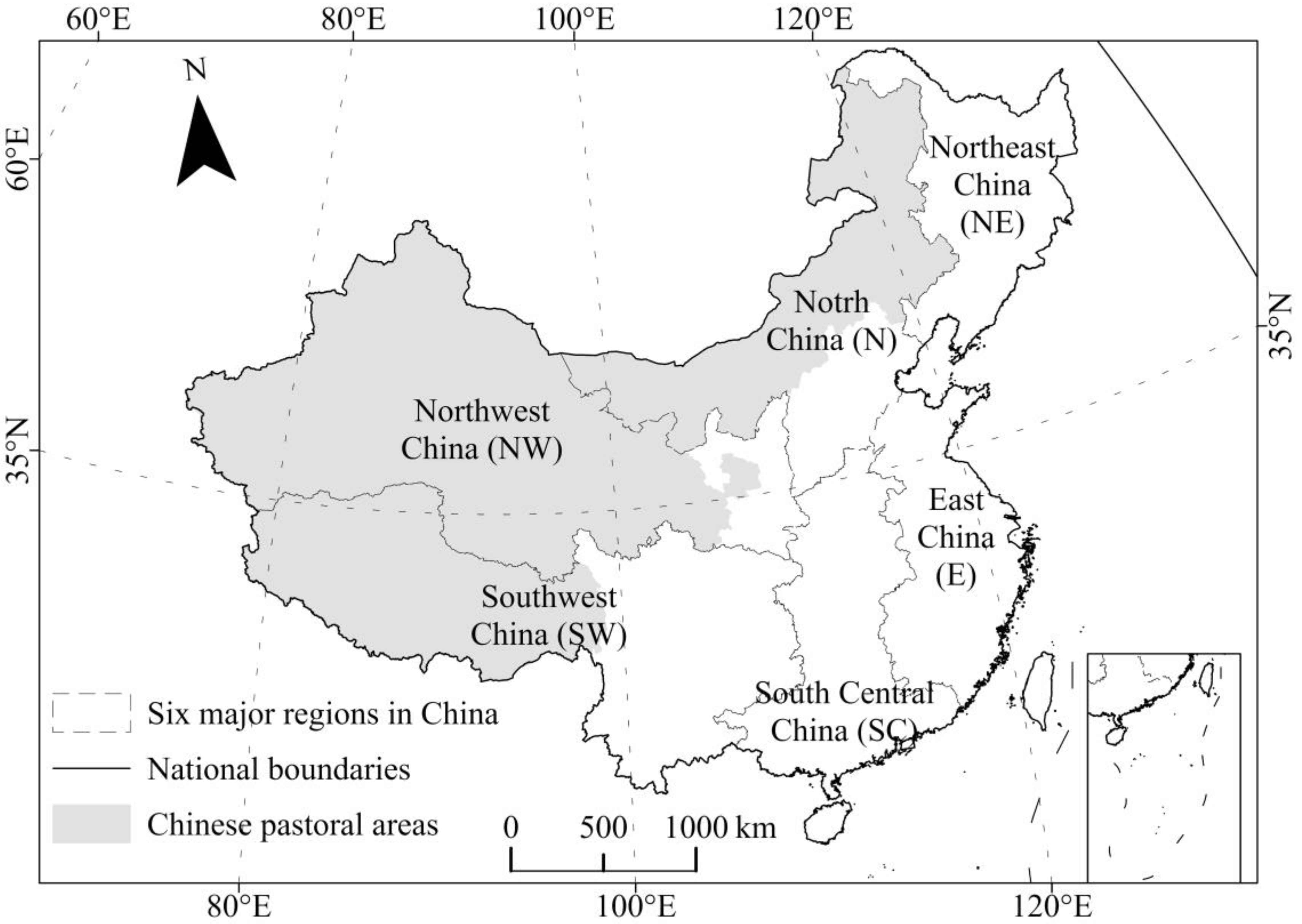
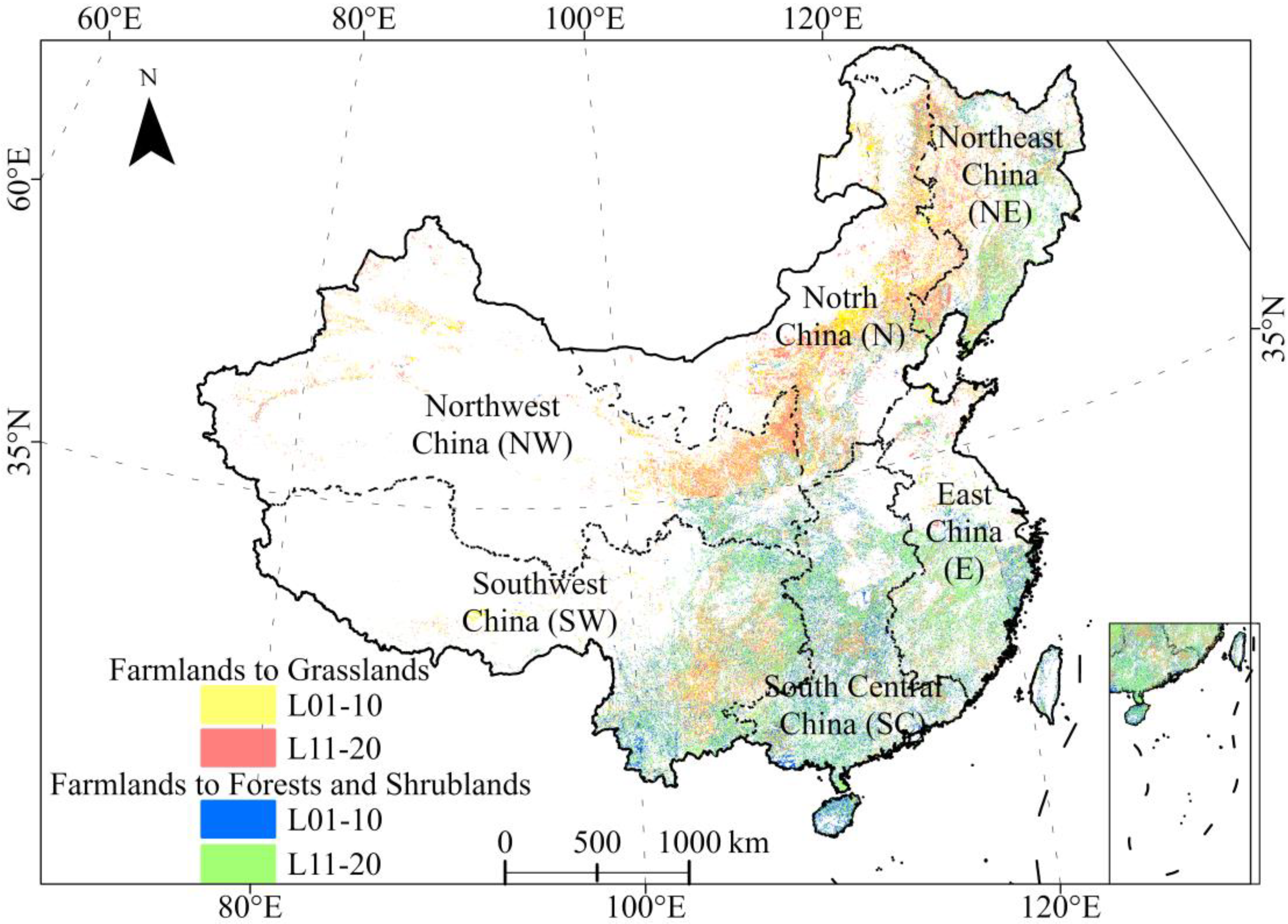
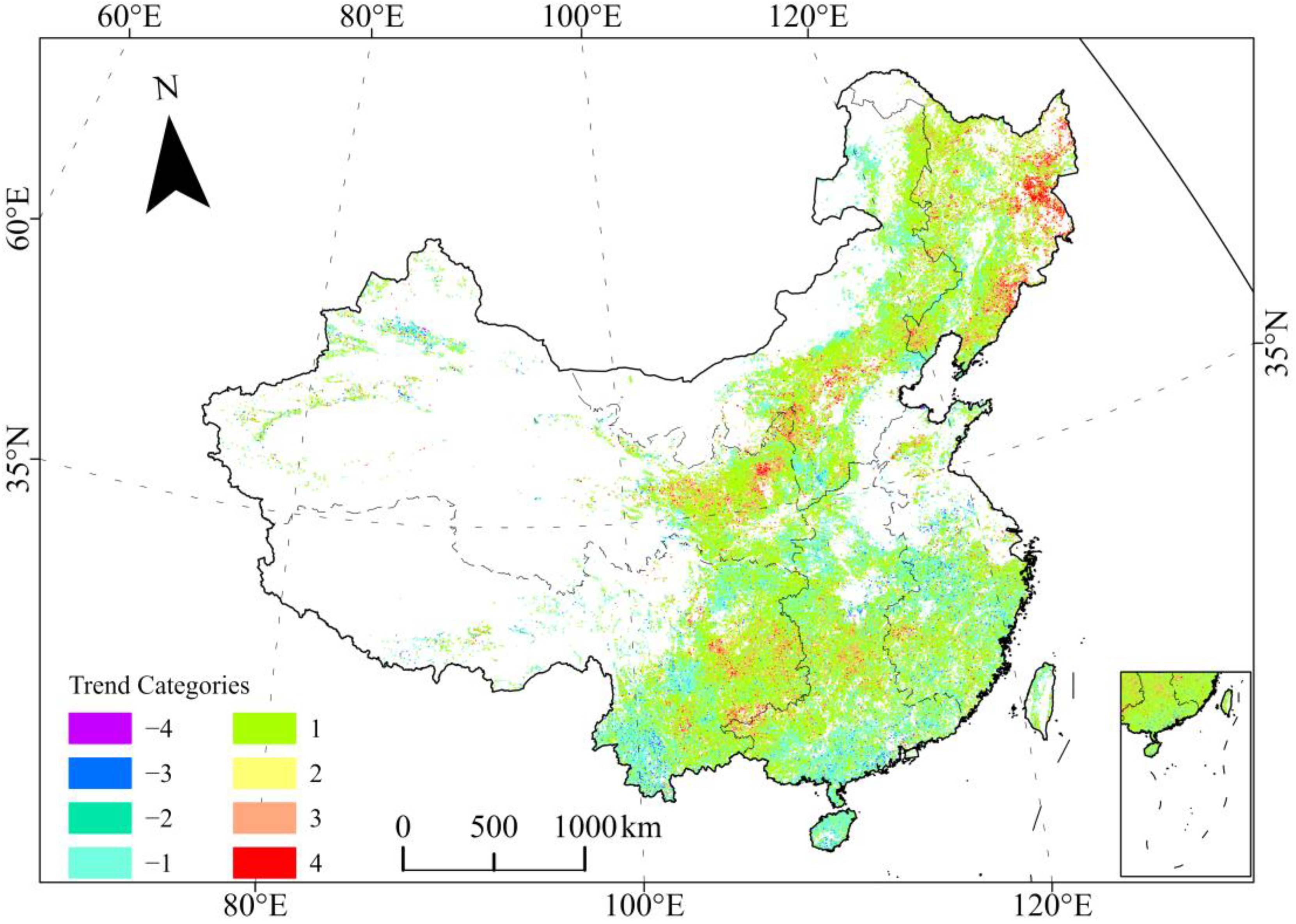
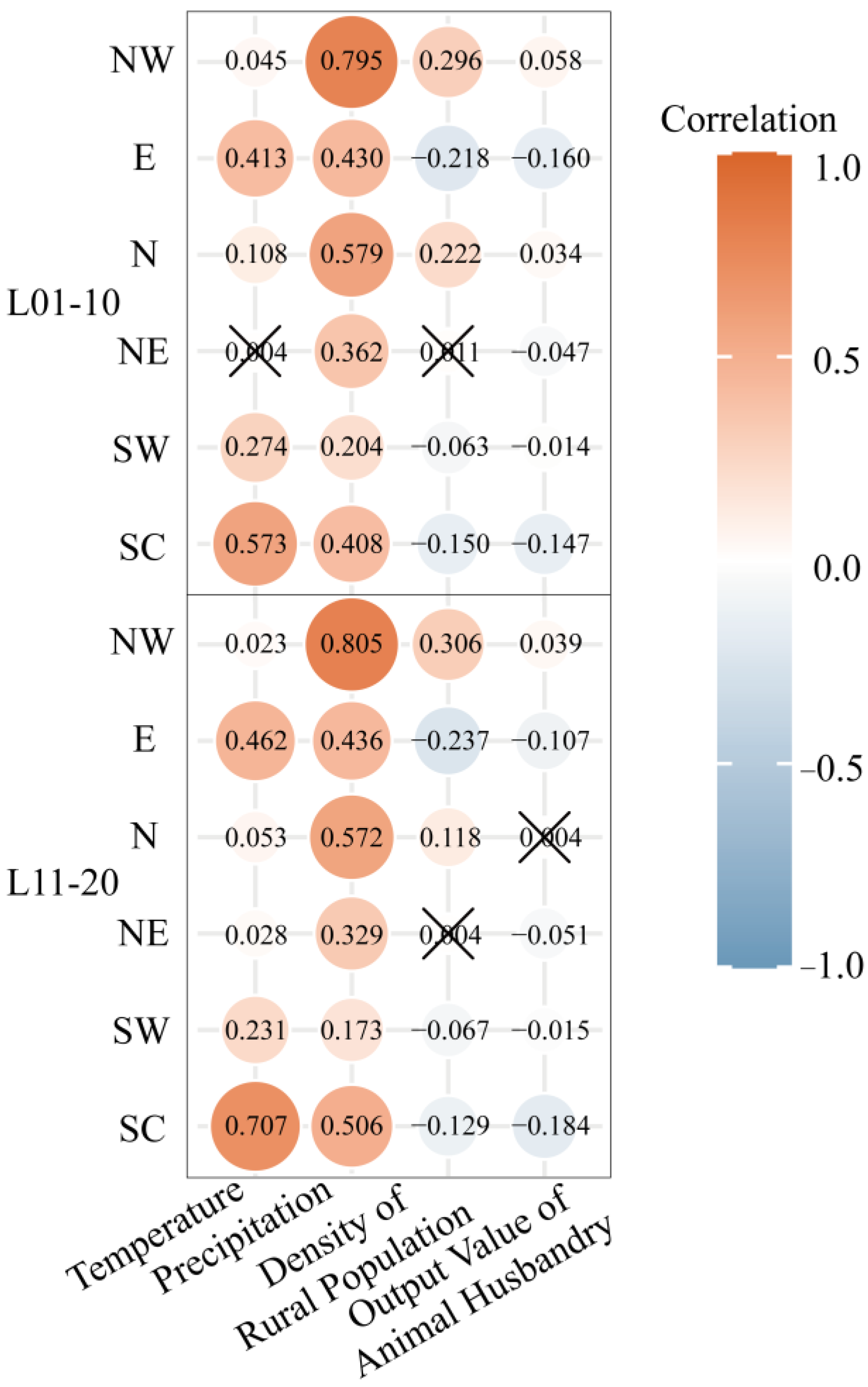
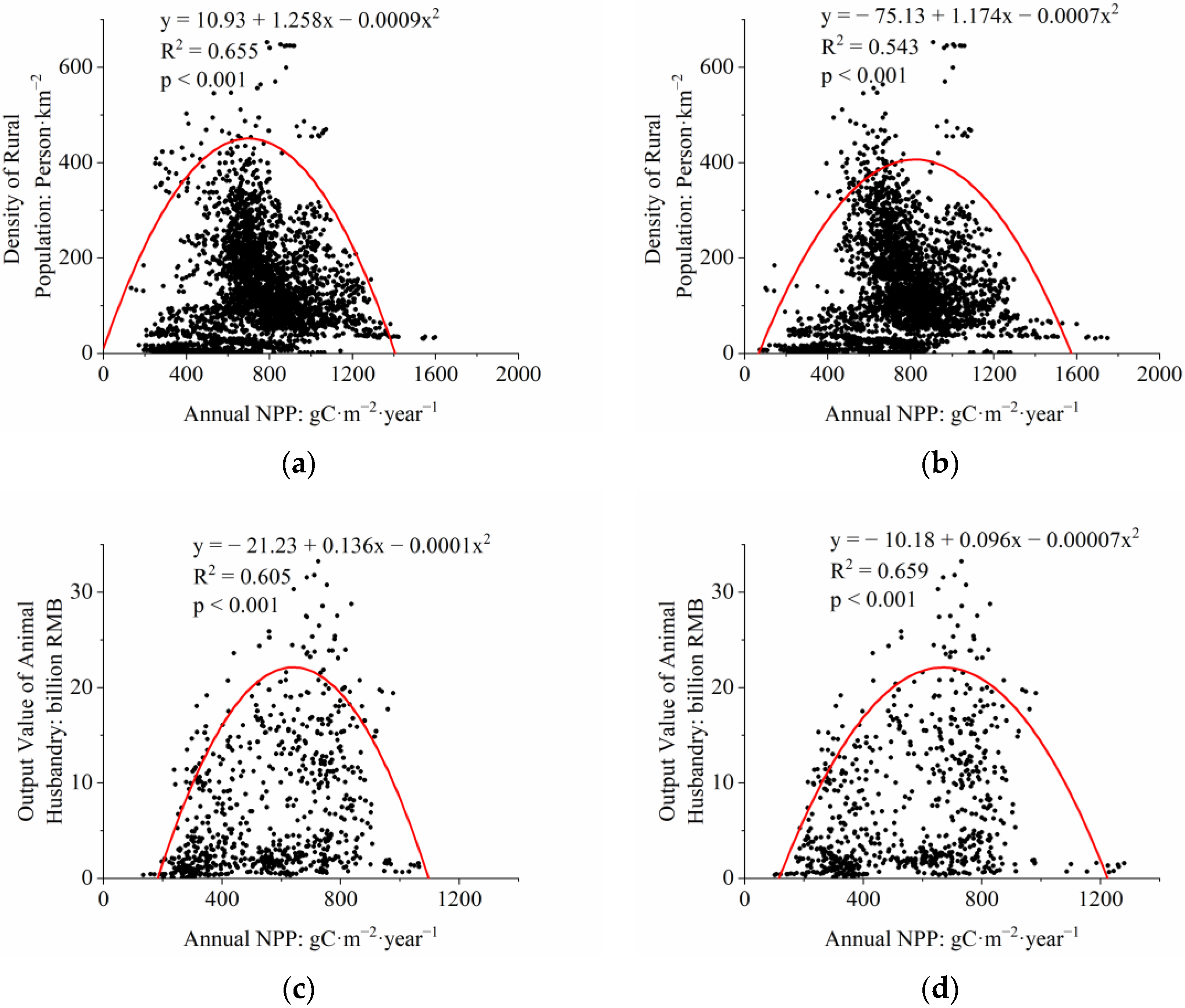
| Group of Retired Farmlands | Land Conversion Type | NE | N | E | NW | SW | SC |
|---|---|---|---|---|---|---|---|
| L01–10 | To forests and shrublands | 6248.34 | 3969 | 10,818.36 | 4744.17 | 18,509.31 | 26,404.38 |
| To grasslands | 8712.36 | 22,658.94 | 3408.48 | 11,101.86 | 9725.67 | 4996.89 | |
| L11–20 | To forests and shrublands | 11,634.03 | 3232.71 | 15,419.97 | 4361.85 | 20,088.81 | 21,274.65 |
| To grasslands | 9579.06 | 17,849.97 | 3986.82 | 9901.44 | 8803.89 | 4092.12 |
| Group of Retired Farmlands | Year | Annual NPP (gC·m−2·Year −1) | |||||
|---|---|---|---|---|---|---|---|
| NE | NW | SW | SC | E | N | ||
| L01–10 | 2011 | 632.56 | 534.73 | 890.34 | 842.80 | 822.43 | 491.12 |
| 2012 | 691.51 | 578.58 | 841.94 | 841.66 | 855.53 | 551.59 | |
| 2013 | 673.97 | 584.40 | 917.12 | 872.12 | 826.74 | 580.40 | |
| 2014 | 683.32 | 588.37 | 895.52 | 855.03 | 844.99 | 561.12 | |
| 2015 | 692.02 | 579.25 | 972.97 | 913.92 | 889.83 | 541.28 | |
| 2016 | 689.01 | 580.68 | 963.43 | 913.25 | 866.39 | 573.25 | |
| 2017 | 693.13 | 585.00 | 941.29 | 899.10 | 867.77 | 563.44 | |
| 2018 | 681.28 | 616.57 | 938.70 | 916.97 | 920.11 | 568.71 | |
| 2019 | 730.02 | 623.79 | 939.64 | 855.52 | 829.80 | 605.34 | |
| 2020 | 787.22 | 648.10 | 883.01 | 875.23 | 846.06 | 547.49 | |
| L11–20 | 2011 | 656.70 | 523.30 | 880.76 | 845.32 | 840.12 | 477.77 |
| 2012 | 720.03 | 573.02 | 833.98 | 840.83 | 876.69 | 546.32 | |
| 2013 | 700.70 | 578.10 | 921.68 | 872.28 | 837.28 | 562.85 | |
| 2014 | 707.25 | 583.15 | 893.28 | 859.53 | 877.12 | 549.81 | |
| 2015 | 724.36 | 570.37 | 976.22 | 919.06 | 912.73 | 530.13 | |
| 2016 | 726.10 | 571.05 | 963.10 | 917.86 | 886.71 | 559.53 | |
| 2017 | 712.11 | 577.13 | 941.48 | 904.67 | 893.72 | 552.44 | |
| 2018 | 706.46 | 610.40 | 947.68 | 916.33 | 942.04 | 557.08 | |
| 2019 | 763.05 | 617.93 | 947.24 | 852.65 | 845.69 | 595.65 | |
| 2020 | 802.53 | 637.82 | 891.64 | 882.56 | 873.12 | 541.29 | |
| Group of Retired Farmlands | Trend Categories | NE | NW | SW | SC | E | N | Total |
|---|---|---|---|---|---|---|---|---|
| L01–10 | 4 | 1498 | 757 | 697 | 558 | 258 | 711 | 4479 |
| 3 | 3474 | 2782 | 2963 | 2702 | 1097 | 2977 | 15,995 | |
| 2 | 1135 | 1068 | 1206 | 1166 | 467 | 1390 | 6432 | |
| 1 | 10,123 | 11,006 | 18,342 | 19,799 | 9044 | 19,391 | 87,705 | |
| −1 | 2151 | 3625 | 10,402 | 13,377 | 5914 | 7973 | 43,442 | |
| −2 | 29 | 88 | 357 | 357 | 196 | 168 | 1195 | |
| −3 | 49 | 185 | 713 | 645 | 402 | 228 | 2222 | |
| −4 | 8 | 51 | 177 | 148 | 147 | 31 | 562 | |
| L11–20 | 4 | 1997 | 655 | 805 | 429 | 339 | 644 | 4869 |
| 3 | 4839 | 2471 | 3285 | 2092 | 1537 | 2558 | 16,782 | |
| 2 | 1695 | 1036 | 1411 | 916 | 703 | 1143 | 6904 | |
| 1 | 14,444 | 10,069 | 19,912 | 15,967 | 12,470 | 15,632 | 88,494 | |
| −1 | 3083 | 3068 | 9433 | 11,061 | 8106 | 5688 | 40,439 | |
| −2 | 35 | 76 | 251 | 284 | 241 | 110 | 997 | |
| −3 | 80 | 172 | 475 | 467 | 452 | 219 | 1865 | |
| −4 | 7 | 62 | 97 | 87 | 81 | 34 | 368 |
Disclaimer/Publisher’s Note: The statements, opinions and data contained in all publications are solely those of the individual author(s) and contributor(s) and not of MDPI and/or the editor(s). MDPI and/or the editor(s) disclaim responsibility for any injury to people or property resulting from any ideas, methods, instructions or products referred to in the content. |
© 2023 by the authors. Licensee MDPI, Basel, Switzerland. This article is an open access article distributed under the terms and conditions of the Creative Commons Attribution (CC BY) license (https://creativecommons.org/licenses/by/4.0/).
Share and Cite
Xie, Y.; Ma, Z.; Fang, M.; Liu, W.; Yu, F.; Tian, J.; Zhang, S.; Yan, Y. Analysis of Net Primary Productivity of Retired Farmlands in the Grain-for-Green Project in China from 2011 to 2020. Land 2023, 12, 1078. https://doi.org/10.3390/land12051078
Xie Y, Ma Z, Fang M, Liu W, Yu F, Tian J, Zhang S, Yan Y. Analysis of Net Primary Productivity of Retired Farmlands in the Grain-for-Green Project in China from 2011 to 2020. Land. 2023; 12(5):1078. https://doi.org/10.3390/land12051078
Chicago/Turabian StyleXie, Yuanming, Zemeng Ma, Mingjie Fang, Weiguo Liu, Feiyan Yu, Jiajing Tian, Shuoxin Zhang, and Yan Yan. 2023. "Analysis of Net Primary Productivity of Retired Farmlands in the Grain-for-Green Project in China from 2011 to 2020" Land 12, no. 5: 1078. https://doi.org/10.3390/land12051078
APA StyleXie, Y., Ma, Z., Fang, M., Liu, W., Yu, F., Tian, J., Zhang, S., & Yan, Y. (2023). Analysis of Net Primary Productivity of Retired Farmlands in the Grain-for-Green Project in China from 2011 to 2020. Land, 12(5), 1078. https://doi.org/10.3390/land12051078





